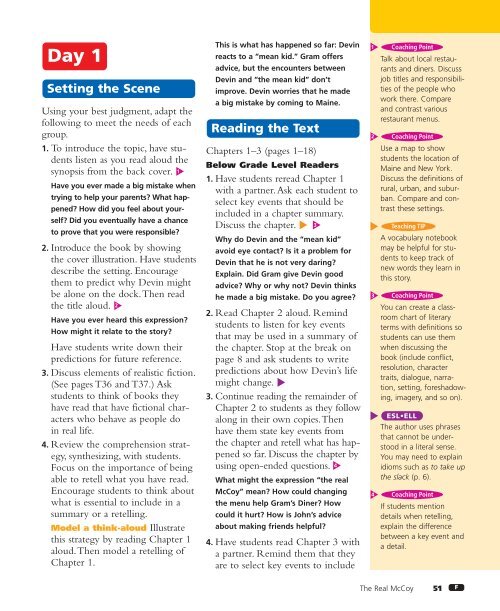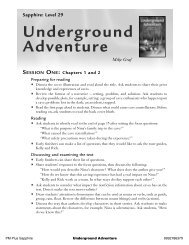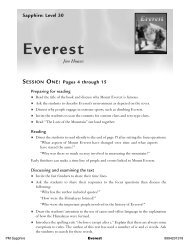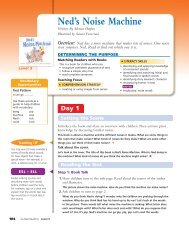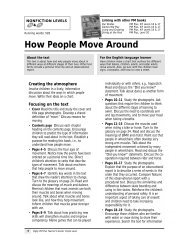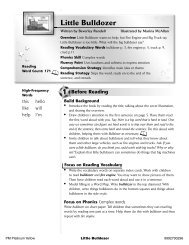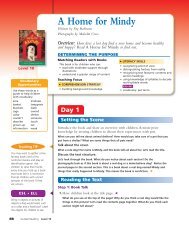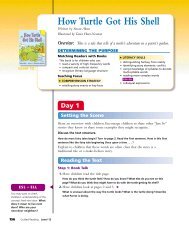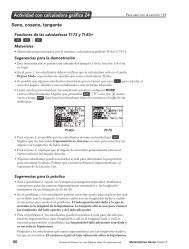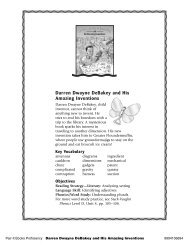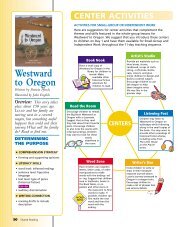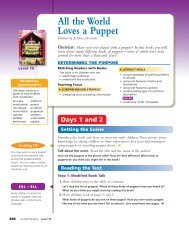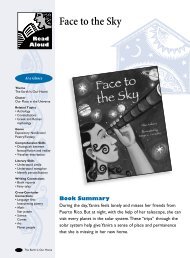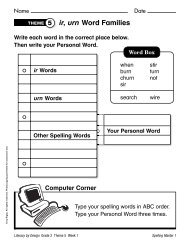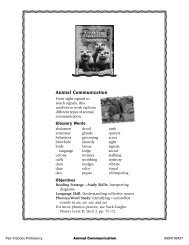Realistic fiction The Real McCoy – Rigby
Realistic fiction The Real McCoy – Rigby
Realistic fiction The Real McCoy – Rigby
Create successful ePaper yourself
Turn your PDF publications into a flip-book with our unique Google optimized e-Paper software.
Day 1<br />
1<br />
Setting the Scene<br />
Using your best judgment, adapt the<br />
following to meet the needs of each<br />
group.<br />
1. To introduce the topic, have students<br />
listen as you read aloud the<br />
synopsis from the back cover.<br />
Have you ever made a big mistake when<br />
trying to help your parents? What happened?<br />
How did you feel about yourself?<br />
Did you eventually have a chance<br />
to prove that you were responsible?<br />
2. Introduce the book by showing<br />
the cover illustration. Have students<br />
describe the setting. Encourage<br />
them to predict why Devin might<br />
be alone on the dock.<strong>The</strong>n read<br />
the title aloud.<br />
Have you ever heard this expression?<br />
How might it relate to the story?<br />
Have students write down their<br />
predictions for future reference.<br />
3. Discuss elements of realistic <strong>fiction</strong>.<br />
(See pages T36 and T37.) Ask<br />
students to think of books they<br />
have read that have <strong>fiction</strong>al characters<br />
who behave as people do<br />
in real life.<br />
4. Review the comprehension strategy,<br />
synthesizing, with students.<br />
Focus on the importance of being<br />
able to retell what you have read.<br />
Encourage students to think about<br />
what is essential to include in a<br />
summary or a retelling.<br />
Model a think-aloud Illustrate<br />
this strategy by reading Chapter 1<br />
aloud.<strong>The</strong>n model a retelling of<br />
Chapter 1.<br />
This is what has happened so far: Devin<br />
reacts to a “mean kid.” Gram offers<br />
advice, but the encounters between<br />
Devin and “the mean kid” don’t<br />
improve. Devin worries that he made<br />
a big mistake by coming to Maine.<br />
Reading the Text<br />
Chapters 1<strong>–</strong>3 (pages 1<strong>–</strong>18)<br />
Below Grade Level Readers<br />
1. Have students reread Chapter 1<br />
with a partner.Ask each student to<br />
select key events that should be<br />
included in a chapter summary.<br />
Discuss the chapter.<br />
Why do Devin and the “mean kid”<br />
avoid eye contact? Is it a problem for<br />
Devin that he is not very daring?<br />
Explain. Did Gram give Devin good<br />
advice? Why or why not? Devin thinks<br />
he made a big mistake. Do you agree?<br />
2. Read Chapter 2 aloud. Remind<br />
students to listen for key events<br />
that may be used in a summary of<br />
the chapter. Stop at the break on<br />
page 8 and ask students to write<br />
predictions about how Devin’s life<br />
might change.<br />
3. Continue reading the remainder of<br />
Chapter 2 to students as they follow<br />
along in their own copies.<strong>The</strong>n<br />
have them state key events from<br />
the chapter and retell what has happened<br />
so far. Discuss the chapter by<br />
using open-ended questions.<br />
What might the expression “the real<br />
<strong>McCoy</strong>” mean? How could changing<br />
the menu help Gram’s Diner? How<br />
could it hurt? How is John’s advice<br />
about making friends helpful?<br />
4. Have students read Chapter 3 with<br />
a partner. Remind them that they<br />
are to select key events to include<br />
Talk about local restaurants<br />
and diners. Discuss<br />
job titles and responsibilities<br />
of the people who<br />
work there. Compare<br />
and contrast various<br />
restaurant menus.<br />
Use a map to show<br />
students the location of<br />
Maine and New York.<br />
Discuss the definitions of<br />
rural, urban, and suburban.<br />
Compare and contrast<br />
these settings.<br />
A vocabulary notebook<br />
may be helpful for students<br />
to keep track of<br />
new words they learn in<br />
this story.<br />
You can create a classroom<br />
chart of literary<br />
terms with definitions so<br />
students can use them<br />
when discussing the<br />
book (include conflict,<br />
resolution, character<br />
traits, dialogue, narration,<br />
setting, foreshadowing,<br />
imagery, and so on).<br />
<strong>The</strong> author uses phrases<br />
that cannot be understood<br />
in a literal sense.<br />
You may need to explain<br />
idioms such as to take up<br />
the slack (p. 6).<br />
If students mention<br />
details when retelling,<br />
explain the difference<br />
between a key event and<br />
a detail.<br />
<strong>The</strong> <strong>Real</strong> <strong>McCoy</strong> 51 F


